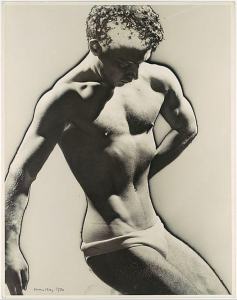
Fashioning Decline
by Clemmie Read | August 9, 2022
“It is quite consummate, is it not!” cries the Aesthetic Bridegroom of his new teapot, in a Punch cartoon of 1880. “It is, indeed!” replies his Intense Bride. “Oh, Algernon, let us live up to it!” Let us surround ourselves with beautiful things, and let those selves live up to them.
The hope to live up to the beauty of one’s objects is a recurring cry of the fin-de-siècle Decadents. Like the movement itself, it teeters between the satire of Aestheticism, the overarching movement which prized aesthetic value above all else and, paradoxically, a sincere preoccupation with self-styling in that very manner. Even though Stephen Greenblatt’s literary historicism roots the concept of ‘self-fashioning’ in the literature of the Renaissance court, nowhere is this ambition more apparent than in Aestheticism.[1] For the aesthete, the self is not only constructed but stylistically and materially displayed – like a Victorian chatelaine’s drawing room, it is an expression of personal taste calculated to win the approval of society. When this hedonistic obsession with the arts was pejoratively labelled as Decadence and then championed as such, construction of the self became intensely counter-intuitive. “I find it harder and harder every day to live up to my blue china,” lamented Oscar Wilde while a budding aesthete at Oxford, characteristically somewhere between satire and insistent sincerity. Blue china might indeed prove hard to live up to in real life. This fixation on materiality, after all, was originally fictional: it belonged not to the real practice of the Aesthetic movement, but to Punch’s fictional parodies of Decadent ‘chinamania’.
Is it possible to associate a movement centred around self-indulgence and social decay with the ambitions of self-fashioning? The latter’s fixation upon artificial construction is evidently aligned with the aesthete’s own fixation upon artistic construction, but their attitudes to social life seem polarised. Self-fashioning may not have the same fixation on moral self-improvement as earlier High Victorianism, but it belongs originally to the ambitious courtier of the early modern state, where self-styling is never far from social self-advancement. It is far, apparently, from pointless self-indulgence. There is a paradoxical incompatibility in self-indulgence and social self-advancement parallel to the paradox in the Decadent conception of the arts: we fall between a desire to transcend the everyday social world through beauty, and an intense fixation on the consumption of the material artefact, a consumption which is meant to support their ideal of removal from society. But if we re-read the self-professed Decadent as only superficially removed from society, while actually preoccupied with the perception of their constructed self, this mode of self-indulgence to the point of decay becomes not only compatible with, but a critical mode of, socioeconomically motivated self-fashioning.
The dilettante artist of another Punch cartoon cries: “Art is for the Few, Father, and the higher the Art, of course the fewer the Few. The highest art of all is for One. That Art is mine. That One is – Myself.” The more one conflates artistic appreciation with exclusivity, the smaller one’s audience becomes, until, eventually, only one’s consummately tasteful self remains. The general mood of the aesthete is ennui, boredom with society and desire to be alone with oneself. Yet their preoccupation with exclusivity – what Punch dubs ‘few[ness]’ – belongs not to artistic isolation but to class consciousness. Decadent self-fashioning is chiefly an expression of refinement of artistic appreciation which is in turn an expression of cultural capital. According to Pierre Bourdieu, this is only a “better concealed” form of economic capital, the visual expression of the aristocratic habitus.[2] This is perhaps clearest in the styling of both Wilde’s Dorian Gray and fellow literary aesthetes like J. K. Huysman’s Jean Des Esseintes as manic collectors. In collecting, the aesthete explicitly displays cultural and economic capital by wielding the funds to purchase art as well as the education to appreciate it. Choices like these act as aesthetic symbols: an expression of taste operates as a kind of metonym for character, a choice in clothing a symbol of essential refinement or essential vulgarity. Here, self-fashioning approaches a kind of symbolic literary characterisation.
But for the Decadents, this aesthetic self-fashioning tends towards shutting the green baize door rather than opening it. As Bourdieu notes, those who aspire towards the ostensible ideal of taste will follow its rules religiously, but the person “sure of his cultural identity,” who is secure in endowed capital, “can play with the rules of the cultural game” with performed insouciance towards the rules of taste.[3] Therein lies the tragedy of Punch’s resident parvenu, Swellington, who “collects Blue China, because it’s the thing to do” in the hopes of being introduced to “two or three Cabinet Ministers” in the process. But he only meets a laundry list of aspiring decadents like himself: Messrs. “Robinson, Smith, Jones, Brown, Perkins, Blenkinsop, and Parker, who all collect Blue China.” The apparent attainment of cultural capital is proven false, and successful self-fashioning is revealed to be the privilege of a select few.
Swellington collects blue china years before Wilde makes his own claim, which consciously builds on these parodies. All of Punch’s comic dandies were parodically alien, pejoratively un-English, un-manly, un-gentlemanly, and Wilde and his contemporaries plagiarised this into a self-modelled figure constructed round the effeminate, Francophilic, and sensuous. They were intoxicating, in part because they were alien, in part because their identity had all the appeal of artistic construction. A human being is a kind of cultural artefact: our behaviours are conditioned by our culture and our conscious responds to its demands. When Wilde promoted Gilbert and Sullivan’s Patience; or, Bunthorne’s Bride on a tour in the United States, the general understanding was that he was the model for the poet Bunthorne. During the tour, however, Wilde in turn modelled himself on the character to appeal to the crowds. Matthew Arnold, in demarcating the ‘man of culture’ from the ‘philistine’ (who made up, in his terms, most of the Victorian populace), essentially pinpoints aesthetes like Wilde as conscious of their status as cultural product, people involved in their own production.[4]
Yet to construct an identity as an artefact soon becomes self-defeating. The lyric persona of the aesthete, the aesthetic ‘I’, belongs to comic narrative verse. This is a personality which comes with a set genre and with no real psychological depth. For Wilde’s manipulative Lord Henry Wotton, the young protagonist Dorian Gray is a boy who “could be fashioned into a marvellous type” because he has “the white purity of boyhood, and beauty such as old Greek marbles kept for us.” The quality he prizes aesthetically, in both boyhood and marble, is tractability – just as marble can be sculpted into shape, so too can an individual’s identity be moulded in their adolescence. The form of the human youth is prized partly because it carries the potential of so much change ahead; where this form is captured in marble, it is dehumanised entirely. Whether a block of material or a literary character, something that can be fashioned is invariably lifeless, devoid of agency. The human is reduced to material alone, or to an impersonal chisel crafting a false identity. If the self splits into the pragmatic fashioning agent and the artificial marble façade, can either qualify as a real human being? As Max Beerbohm celebrates with irony in his Defence of Cosmetics, the lead tracings in cosmetics have been eradicated by this period and “[a]rtifice will claim not another victim from among her worshippers.” But the suggestion that self-fashioning tends towards decay is clearly there: artifice in life begets hollowness and death, and the death of art, too. Artistic creation cannot be infinitely self-productive. Decadent artworks represented a world that was already inherently aestheticized, and art must eventually have fuel outside itself. In isolation, it is even lethal: when Huysman’s Des Esseintes studs his tortoise’s shell with gemstones, the tortoise dies under the sheer weight. Neither wealth nor beauty can compensate for life.
It is wealth, as much as beauty, which forms the unmistakeable foundation of the movement, and which inevitably dooms the socially aspirational to failure. Decadence in the broader sense of degeneracy and debauchery belongs only to those who can afford to be decadent financially. For every successful individual dandy there are failing legions of Swellington Spiffs, bourgeois social climbers, hoping to achieve the prerequisites of social Decadence, the real status and capital, by imitating its expressions. Consider George and Weedon Grossmith’s Diary of A Nobody, the comic diary of a middle-class man deluded into thinking he might be “Somebody”. He fashions himself as hedonistic upon occasion. He drinks copious champagne at the Lord Mayor’s Ball (to which he is very excited to be invited) and collapses because his constitution is untrained. At another much-anticipated ball, he helps his party to claret, champagne, ices, and cigars, only to be charged for a sum he cannot afford. Or, outside of (total) satire, Beerbohm observes the “countless gentlemen who walk about town in the time of its desertion from August to October, artificially bronzed, as though they were fresh from the moors or from the Solent. This, I conceive, is done for purely social reasons.” These men attempt to self-fashion as Decadent because if one is visibly self-indulgent, visibly of such high status, one can squander one’s time and money as one likes. But to rise in society by performing a decline in lifestyle is a substantial risk indeed. And the truly accepted arbiters of artistic rights and wrongs, the puncturing pen of Beerbohm or Punch magazine, prove that the risk is not worth taking. In the eyes of society, to emulate indulgence and decline without the means to do so is not to self-fashion, not to self-advance. It is only to indulge and decline. ∎
[1] Stephen Greenblatt, Renaissance Self-Fashioning, (Chicago: University of Chicago Press, 2005), p. 1.
[2] Pierre Bourdieu, State Nobility: Elite Schools in the Field of Power (Stanford: Stanford University Press, 1996), p. 318.
[3] Pierre Bourdieu, Language and Symbolic Power (Cambridge, M. A.: Harvard University Press, 1991), p. 124-125.
[4] Matthew Arnold, Culture and Anarchy (London: Smith, Elder & Co, 1869), p. xxx.
Words by Clemmie Read. Art by Betsy McGrath.




